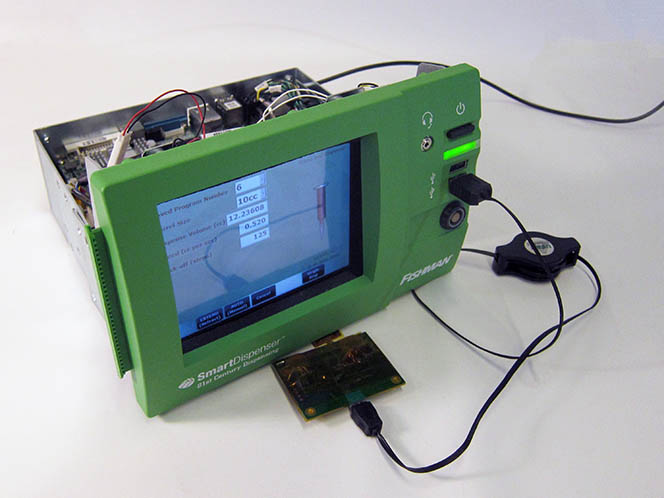Fluid dispensing system with a Windows 7 touch screen interface.
Context
The customer needed to replace their aging fluid dispensing technology and wanted to take advantage of new technologies that were not available when they built their existing product. They originally contracted with another engineering firm, but they were not able to complete the work in the desired time-frame.
The key challenges included:
- Produce a device that exactly reproduced the performance characteristics of the legacy system.
- Add a brand new touch screen Graphic User Interface.
- Add a brand new PLC interface for automated environments.
- Bring a partially designed and implemented solution to completion.
- Deliver a complete product within a strict time constraint.
Solution
We developed a fluid dispensing system with a Windows 7 touch screen interface. BCA worked on the electronics, firmware and software for the device. The device provides a Smartphone-like interface to the fluid dispensing software as well as networking, remote system monitoring, document viewing and numerous other features. The software runs on a Single Board Computer (SBC), which is internally connected to a custom electronics board via an RS232 serial interface. The custom electronics includes its own processor, running custom firmware.
BCA first evaluated the existing state of the development project. Difficult engineering decisions were made regarding which subsystems could be carried forth to completion and which needed redesign and re-implementation.
A thorough review of the electronics design (started by the other engineering firm) was undertaken, and a number of design changes were implemented to correct functional issues. In addition, the design was modified in a number of ways to improve reliability, manufacturing yield, and to meet regulatory compliance. Particular attention was paid to ensure that the essential performance met or exceeded that of the legacy product.
The firmware was redesigned to make it smarter in order to support faceless (automated) operation. The stepper motor control code was redesigned to exactly match the legacy characteristics without impacting (or being impacted by) the serial interface communication with the SBC. The firmware interface to the motor controller code was modified to accept commands via the PLC.
The fluid dispensing software was converted to a WPF application to accommodate the customer’s requirements for gestures support. Panning gestures were used to kick off WPF animation of the applications screens. We corrected the problems with the software calculations to ensure the fluid dispensing was as reliable as the company’s existing product. Additional functionality was added for interfacing to a scale, a PLC device and for sending email. Translations were added to provide versions of the application in Spanish, French, German and Chinese.
We wrote a second WPF application to emulate the look and feel of a Smartphone with touch icons to start applications and gesture support for panning and zooming. This application provides links to custom applications including the fluid dispensing software, existing Windows 7 applications, such as Microsoft Word and Excel and other devices such as webcams for video streaming over the internet.
The size of BCA and the diversity of our engineering team allowed for the nimble allocation of staffing to solve the problems in a timely manner as they were presented over the course of the project.

